Jewish Funerals and Traditions
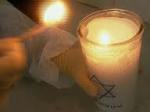
Many Jewish funerals are based upon a combination of minhag (traditional custom) and mitzvot (good deeds or religious obligation) taken from Judaism's classical Torah and rabbinic texts. The details of observance and practice vary according to each Jewish community.
Upon receiving the news of the individuals passing, the following blessing is recited:
-
Barukh ata Adonai Eloheinu melekh ha'olam, dayan ha-emet.
This translates to: "Blessed are You, LORD, our God, King of the universe, the True Judge."
There is also a Jewish funeral custom of rending one's clothes at the moment one hears news of a passing, which in modern times has been frequently interpreted by the cutting of a man's tie. A Jewish man will cut off the end of whatever tie he is wearing at the moment he hears the news.
Chevra Kadisha

The Chevra Kadisha ("holy group") is a Jewish burial society usually consisting of men and women volunteers, who prepare the deceased for burial. Their role is to insure that the body of the deceased is ritually cleansed and dressed in shrouds.
In many urban areas, the local chevra kadishas are affiliated with the local synagogue. They often own their own burial plots in various local cemeteries. Some will pay an annual token membership fee to a particular chevra kadisha so that, in time of immediate need, the society will tend to the body of the deceased according to Jewish law, and the burial plot will be at an appropriate nearby Jewish cemetery.
If, at the time of burial, there are no gravediggers are available, then it becomes the responsibility of the male society members to ensure that graves are dug. In Israel, members of chevra kadishas consider it an honor to not only to prepare the body for burial, but to also participate in digging the grave for a fellow Jew's body, especially if the deceased was considered to be a righteous individual.
Many burial societies hold one or two annual fast days and organize regular study sessions to remain up to date with the relevant articles of Jewish law. In addition, most burial societies also support families during the shiva (traditional week of mourning) by arranging prayer services, preparing meals, and providing other services for the mourners.
Preparing the Body - Taharah

As part of Hebrew custom, there are three major stages to preparing the body for a Jewish funeral: washing (rechitzah), ritual purification (taharah), and dressing (halbashah). The term taharah is used to refer both to the overall process of burial preparation, and to the specific step of ritual purification.
The general sequence for performing taharah is as follows: Blessings, prayers, and readings from Torah, Psalmshia and other Jewish scripture may be recited at several points:
- A sheet that had been covering the body while it awaited taharah is removed and the body is carefully and thoroughly cleaned of dirt, body fluids, solids, and anything else that may be on the skin. All jewelry is also removed.
- The body is purified with water, either by immersion in a mikvah or by pouring a continuous stream in a prescribed manner.
- The body is dried accordingly, then dressed in traditional burial clothing (tachrichim). A sash (avnet) is wrapped around the clothing and tied in the form of the Hebrew letter "shin," representing one of the names of God.
- If a coffin (aron) is being used, it is prepared by removing any linings or other embellishments. A sheet (sovev) is laid into the coffin. Outside the Land of Israel, if the person wore a prayer shawl (tallit) during their life, this shawl is also laid in the coffin for wrapping the body. One of the corner fringes (tzitzit) is removed from the shawl to signify that it will no longer be used for prayer in life.
- The body is then lifted into the coffin and wrapped in the prayer shawl and sheet. Soil from Israel (afar), if available, is placed over various parts of the body and sprinkled in the coffin.
- The coffin is then closed.
Once the body is dressed, the coffin is sealed. Unlike other religions, a Jewish funeral does not have a body viewing or "open casket" at the funeral service. Immediate family members are allowed a visitation right prior to the coffin being sealed to pay their final respects. In Israel, caskets are not used at all, (the only exception being military and state funerals). The body is carried to the grave site wrapped in a tallit.
Once the coffin is closed, the chevra then asks for forgiveness from the deceased for anything that they may have done to offend them or not show proper respect during the taharah. If the body is not taken immediately for burial, guards or watchers (shomrim) sit with the coffin until it is taken for burial. It is traditional to recite Psalms during this time.
The Funeral Service

In Israel, the Jewish funeral service will usually commence at the burial ground. In the US and Canada, the funeral service will usually commence at a funeral home, synagogue or temple, with the mourners and their entourage proceeding to a Jewish cemetery for the burial. In the case of a more prominent person, such as a Rabbi, Rebbe or Rosh Yeshiva, the entire Jewish funeral service with eulogies can be held at the synagogue or yeshiva that the deceased was affiliated with.
Eulogies
A hesped is a eulogy, and it is common that several people speak at the start of the Jewish funeral service at the funeral home, as well as prior to burial at the gravesite. On certain days, such as on Chol HaMo'ed ("intermediate days" of Jewish holidays, eulogies are forbidden.
Burial
The Kevura, or burial, often takes place immediately after death. The Torah requires burial as soon as possible, even for executed criminals. This often means that burial will usually take place on the same day as death, or, if not possible, the next day. Some Reform and other congregations delay burial to allow more time for grieving family members to attend the Jewish funeral and participate in the other post burial rituals.
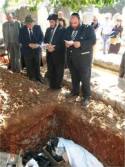
The customs of Jewish funerals regarding burial may have originated from climate. In Biblical times, the climate surrounding Isreal was very hot. This climate caused a dead body to decompose rather quickly. Not only was this generally undesirable, but allowing the dead body of any person to decompose was seen as a sign of great disrespect. Therefore, it became part of the Jewish funeral custom to bury the body as soon as possible. While the practice of embalming and mummification had advanced to a high level in Egypt, these techniques were also seen as disrespectful since it involved a great deal of manipulation and the removal of bodily organs.
Typically, when the Jewish funeral service has ended, the mourners come forward to fill the grave. Symbolically, this gives the mourners closure as they observe the grave being filled in. One Jewish funeral custom is for people present at the funeral to take a spade or shovel, held pointing down instead of up, to show the antithesis of death to life and that this use of the shovel is different from all other uses, to throw three shovelfuls of dirt into the grave. When someone is finished, they put the shovel back in the ground, rather than handing it to the next person, so that they shouldn't pass along their grief. While the grave is being filled in, some Jews may throw in a handful of earth from Israel on the dead body.
Mourning: Keriah and Shiva
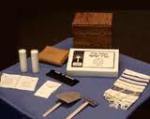
The mourners traditionally make a tear (keriah) in an outer garment either before the Jewish funeral service or immediately after it. The tear should be on the left side for a parent (over the heart and clearly visible) and on the right side for brothers, sisters, children and spouses (and does not need to be visible).
If a son or daughter of the deceased needs to change clothes during the shiva period, he or she must tear the changed clothes. No other family member is required to rend changed clothes during shiva. Neither son nor daughter may ever sew the rent clothes, but any other mourner may mend the clothing 30 days after the burial.
When they get home, the mourners do not shower or bathe for a week, do not wear leather shoes and/or jewelry, men do not shave, and in many communities large wall mirrors in the mourners' home are covered. During many Jewish funerals, it is customary for the mourners to sit on low stools or even the floor, symbolic of the emotional reality of being "brought low" by the grief. The meal of consolation (seudat havra'ah), the first meal eaten on returning from the funeral, traditionally consists of hard boiled eggs and other round or oblong foods. This is often credited to the Biblical story of Jacob purchasing the birthright from Esau with stewed lentils; it is traditionally stated that Jacob was cooking the lentils soon after the death of his grandfather, Abraham.
During this time distant family and friends come to visit or call the mourners to comfort them via "shiva calls".
The Seven Days of Mourning
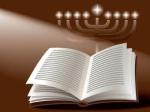
If the mourner returns from the cemetery after the burial before sundown then the day of the Jewish funeral is counted as the first of the seven days of mourning. Mourning generally concludes in the morning of the seventh day. No mourning may occur on Shabbat (the Jewish Sabbath), nor may the burial take place on Shabbat, but the day of Shabbat does count as one of the seven days. If a Jewish holiday occurs after the first day, that curtails the mourning period. If the Jewish funeral occurs during a festival, the start of the mourning period awaits the end of the festival. Some holidays, such as Rosh Hashanah, cancel the mourning period completely.
Stages of Mourning
Aninut: The first stage of mourning is aninut, or "[intense] mourning." An onen (a person in aninut), is considered to be in a state of total shock and disorientation. Thus the onen is exempt from performing mitzvot that require action and attention, such as praying and reciting blessings, wearing tefillin (phylacteries), in order to be able to tend unhindered to the Jewish funeral arrangements. Aninut lasts until the burial is over, or, if a mourner unable to attend the funeral, from the moment he is no longer involved with the funeral itself.
Avelut: Aninut is immediately followed by avelut ("mourning"). An avel ("mourner") does not listen to music or go to concerts, and does not attend any joyous events or parties such as marriages or Bar or Bat Mitzvahs, unless absolutely necessary. (If the date for such an event has already been set prior to the death, it is strictly forbidden for it to be postponed or canceled.) Avelut consists of three distinct periods:
Shiva - 7 (Seven) Days
The first stage of avelut is shiva, a week-long period of grief and mourning. Observance of shiva is referred to by English-speaking Jews as "sitting shiva". During this period, mourners traditionally gather in one home and receive visitors.
It is considered a great mitzvah (commandment) of kindness and compassion, to pay a home visit to the mourners. Traditionally, no greetings are exchanged and visitors wait for the mourners to initiate conversation. The mourner is under no obligation to engage in conversation and may, in fact, completely ignore his visitors. There are various customs as to what to say when taking leave of the mourner(s). One of the most common is to say to them:
Hamakom y'nachem etkhem b'tokh sha'ar avelei tziyon viyrushalayim:
The Place will comfort you among the mourners of Zion and Jerusalem
Depending on the community's customs, others may also add such wishes as: "You should have no more tza'ar (pain)" or "You should have only simchas (celebrations)" or "We should hear only good news (besorot tovot) from each other" or "I wish you long life".
Traditionally, prayer services are organized in the house of mourning. It is customary for the family to lead the services themselves.
Shloshim - 30 (Thirty) Days
The thirty-day period following the death (including shiva), is known as shloshim. During shloshim, a mourner is forbidden to marry or to attend a seudat mitzvah ("religious festive meal"). Men neither shave nor get haircuts during this period.
Since Judaism teaches that a deceased person can still benefit from the merit of mitzvot (deeds commanded by God) done in their memory. It is considered a special privilege to bring merit to the departed by learning Torah in their name. A popular custom is to coordinate a group of people who will jointly study the complete Mishnah during the shloshim period.
Shneim asar chodesh - 12 (Twelve) Months
Those mourning a parent additionally observe a twelve-month period, counted from the day of death. During this period, most activity returns to normal, although the mourners continue to recite the mourner's kaddish as part of synagogue services for eleven months, and there remain restrictions on attending festive occasions and large gatherings, especially where live music is played.
Matzevah - Unveiling of the Tombstone
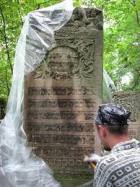
The tombstone (headstone) is known as a matzevah ("monument"). Although there is no Halakhic obligation to hold an unveiling ceremony, the ritual became popular in many communities toward the end of the 19th century. There are varying customs about when it should be placed on the grave. Most communities have an unveiling ceremony a year after the death. Some communities have it as early as a week after the burial. In Israel it is done after the "sheloshim", the first thirty days of mourning. There is no restriction about the timing, other than the unveiling cannot be held during certain periods such as Passover or Chol Ha'Moed.
At the end of the jewish funeral ceremony, a cloth or shroud covering that has been placed on the headstone is removed, customarily by close family members. Services include reading of several psalms (1, 24, 23, 103), Mourners Kaddish (if a minyan is available), and the prayer "El Malei Rachameem." The service may include a brief eulogy for the deceased.
Annual Remembrances: Yahrtzeit

Yahrtzeit, means "Time (of) Year" in Yiddish. The word is also used by non-Yiddish-speaking Ashkenazi Jews, and refers to the annual anniversary of the day of death of a relative. Yahrtzeit literally means "time of [one] year".
The commemoration is widely observed, and based on the Jewish funeral tradition that require mourners to commemorate the death of a relative. Mourners required to fulfill this observance are the children, siblings, spouses and parents of the deceased. The Yahrtzeit falls annually on the Hebrew date of the deceased relative's death according to the Hebrew calendar.
The main halakhic obligation is to recite the mourner's version of the Kaddish prayer three times (evening, morning, and afternoon), and many attend synagogue for the evening, morning, and afternoon services on this day. (During the morning prayer service the mourner's Kaddish is recited at least four times.) As a widely practiced custom, mourners also light a special candle that burns for 24 hours, called a "Yahrzeit candle". Lighting a yahrtzeit candle in memory of a loved one is a minhag ("custom") that is deeply ingrained in Jewish life honoring the memory and souls of the deceased.
Strict Jewish law requires that one should fast on the day of a parent's Yahrzeit, although this is not required, some people do observe the custom of fasting on the day of the Yahrtzeit. Among many Orthodox Jews it has become customary to make a siyum ("celebratory meal"), by completing a tractate of Talmud or a volume of the Mishnah on the day prior to the Yahrtzeit, in the honor of the deceased. A halakha requiring a siyum, upon the completion of such a study, overrides the requirement to fast.
Jewish funeral mourners are required to commemorate the death of a first-relative: mother, father, brother, or sister. The main halakhic obligation is to recite the mourner's version of the Kaddish prayer at least three times: Maariv at the evening services, Shacharit at morning services, and Mincha at the afternoon services.
Many synagogues will have lights on a special memorial plaque on one of the synagogue's walls, with names of synagogue members who have died. Each light will be lit for individuals on their Yahrzeit, and all the lights will be lit for a Yizkor service. Some synagogues will also turn on all the lights for memorial days, such as Yom Ha'Shoah. Most people say it the day after they died.
Visiting the Gravesite
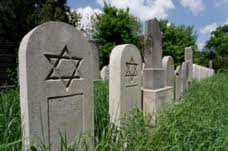
Another Jewish funeral custom for some includes visiting the cemetery on fast days and before Rosh Hashanah and Yom Kippur, when possible, and for a Yahrzeit. Even when visiting the graves of someone they never knew, the visitor may place a small stone at the graveside to show that the grave site was visited and to represent permanence. Another reason for leaving stones part of tending the grave. In Biblical times, gravestones were not used, graves were marked with mounds of stones. So, by placing (or replacing) the stones, one perpetuated the existence of the site. This was also helpful for Cohanim, who needed to avoid spiritual impurity that could be passed on by corpses/graves. Leaving flowers of any kind is not a traditional Jewish funeral practice.
Other Jewish Funeral Customs
Death of an Apostle Jew

According to Jewish law, there is no mourning for an Apostate Jew. This Jewish funeral custom was developed among Ashkenazic Orthodox Jews (including Hassidic and Haredi Jews), that the family would "sit shiva" if and when one of their relatives left the fold of traditional Judaism. The definition of "leaving the fold" varied within communities; some would sit shiva if a family member married a non-Jew; others would only sit shiva if the individual actually converted to another faith, and even then, some would make a distinction between those who chose to do so of their own will, and those who were pressured into conversion. At the height of the Mitnagdim (anti-Hassidic) movement in the early-to-mid 19th century, some Mitnagdim even sat shiva if a family member joined Hassidism. By the mid 20th century, however, Hassidism was clearly recognized by everyone as a valid form of Orthodox Judaism, and thus the practice of sitting shiva for those who realign to Hassidism ceased to exist.
Today, some Orthodox Jews, particularly the more traditional ones from the Haredi and Hassidic communities, continue the practice of sitting shiva for a family member who has left the religious community. Many centrist and left-wing Orthodox Jews, question and may not observe the practice for three reasons. Firstly, declaring the family member "dead" is a very harsh act that could make it much more difficult for the family member to return to traditional practice should they consider doing so. Secondly, the definition of actively "leaving the fold" is rather vague today, especially as the majority of Jews today are not strictly observant Orthodox Jews. Thirdly, recent scholarship has shown that the source of the original custom, a story published in the twelfth century by Rabbi Isaac ben Moses of Vienna in Or Zarua regarding Rabbi Gershom ben Judah, contained a typo and was thus misunderstood. Rabbi Gershom had a son who had converted to Christianity. A text that had been read as, "Rabbi Gershom sat shiva for his son when he converted", turned out to have been "Rabbi Gershom sat shiva for his son who had converted", when the son actually died years later of natural causes.
Death of an Infant
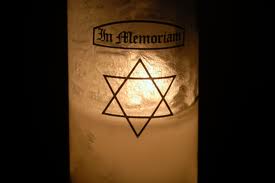
For a child under the age of 30 days, there is no shiva. This is because, in times past with infant mortality being what it was, a child under the age of 30 days was not yet considered viable. Stricter communities hold that the child cannot be mourned in a traditional Jewish funeral manner of sitting shiva. Understandably, this is very difficult for the family (although at the time it was meant to ease the burden on the family), and is not followed by less traditional Jewish sects.
| Funeral Guide | Find a Funeral Home | Send Flowers |